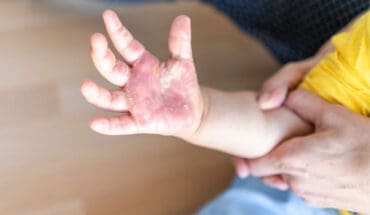It is extremely common for someone who is ill to develop a fever.
What is a fever?
A part of the brain known as the hypothalamus controls body temperature. This usually varies very slightly throughout the day from the normal temperature of 37C (anything between 36.1 and 37.2 are still in the normal range). It is thought that in response to an infection, illness, or some other cause, the hypothalamus may reset the normal body thermostat to a higher temperature. Therefore, resulting in a fever.
How dangerous is a fever?
A fever is not considered dangerous in itself. However, hyperthermia can cause dangerous rises in body temperature. Hyperthermia is an extreme rise in temperature (above 40 C) that can occur as a result of heat stroke, side effects of certain medications or illicit drugs, or a stroke.
When someone experiences hyperthermia, the body is no longer able to control its own body temperature. This is a medical emergency as the body loses the ability to sweat to naturally lower the body temperature. They will need treatment in hospital to reduce their temperature.
Hyperthermia is unusual as most people just experience low grade fevers. Children in particular often spike fevers for no apparent reason. These usually normalise without needing additional medical care.
Seizures and febrile convulsions:
A sharp rise in body temperature can often trigger seizures or convulsions. With babies and small children this is incredibly common, with 1:5 experiencing febrile convulsions. In adults the level of the temperature triggering the seizure tends to by higher. For more information on first aid for Febrile convulsions click here.
In adults a normal temperature is around 37 C
A normal temperature in babies and children is about 36.4C, but this can vary slightly from child to child.
A fever is a high temperature of 37.8C or more.
Fever is the body’s natural response to fighting infections like coughs and colds
Taking a temperature
Use a digital thermometer, which you can buy from pharmacies and supermarkets, to take your temperature. It is possible to use specific thermometers to take temperatures orally (in the mouth), tympanic (in the ear) axillary (under the armpit), or rectally (in the bottom). You can also buy skin sensor thermometers that ready the temperature by scanning the forehead.
Each way of taking the temperature will give a slightly different ‘normal’ reading. Typically an ear (tympanic) temperature is 0.5°F (0.3°C) to 1°F (0.6°C) higher than an oral temperature. An armpit (axillary) temperature is usually 0.5°F (0.3°C) to 1°F (0.6°C) lower than an oral temperature.
You can also gauge whether or not someone has a temperature of fever by looking at them and feeling their forehead, back or stomach.
If they have a fever, they will generally:
- feel hotter than usual to the touch on their forehead, back or tummy
- be sweaty or clammy
- have red cheeks and a flushed face
Caring for someone with a high temperature:
Be aware that it is possible that the person you are caring for could have a contagious illness. Therefore, take additional steps to ensure you do not put yourself at risk of catching it.
Regular and thorough hand washing is critical.
Do:
- open windows and allow air to circulate, but don’t leave them in a draft or let them get cold
- give them plenty of fluids
- look out for signs of dehydration
- give them small portions of easily digested food if they want it
- check on them regularly and during the night
- give paracetamol (or ibuprofen if there are no contraindications) if they are in pain or distress. This will also help reduce their fever and make them feel more comfortable.
- get medical advice if you’re worried that they are getting worse, or the fever is not shifting within 3 or 4 days
Things to avoid:
- don’t undress your child or overly sponge them down to cool them – fever is a natural and healthy response to infection. Some people find a cool flannel on their forehead or pulse points is soothing and this can help to reduce the fever and make them feel better.
- avoid covering up in loads of clothes or bedclothes – it is not good to sweat out a fever. Better to wear light cotton nightclothes. Open a window to circulate the air, but don’t sit in a draft.
- never give aspirin to under-16s
- it is not a good idea to combine ibuprofen and paracetamol, unless a GP tells you to
- refrain from giving paracetamol to a child under 2 months
- Do not give ibuprofen to children with asthma.
We can help
First Aid for Life and Onlinefirstaid.com cover the treatment for high and low body temperatures on our courses, including the treatment of febrile convulsions.
Written by Emma Hammett for First Aid for Life
Award-winning first aid training tailored to your needs – Please visit our site and learn more about our practical and online courses. It is vital to keep your skills current and refreshed.
It is strongly advised that you attend a fully regulated Practical or Online First Aid course to understand what to do in a medical emergency. Please visit https://firstaidforlife.org.uk or call 0208 675 4036 for more information about our courses.
First Aid for Life is a multi-award-winning, fully regulated first aid training provider. Our trainers are highly experienced medical, health and emergency services professionals who will tailor the training to your needs. Courses for groups or individuals at our venue or yours.
- What is a seizure? - 13th March 2025
- Febrile Convulsions and Seizures in Children - 13th March 2025
- Why women are less likely to receive CPR or survive cardiac arrest - 6th March 2025






